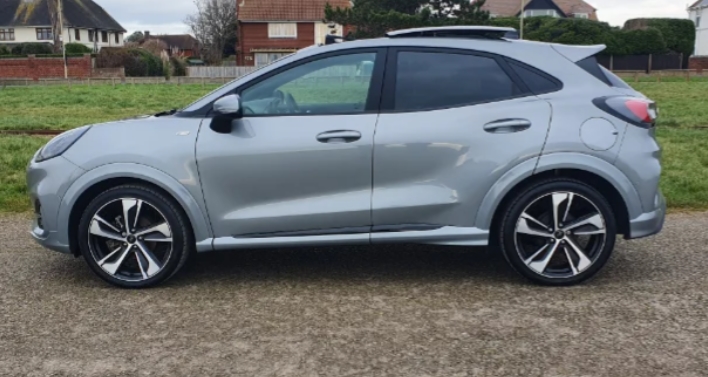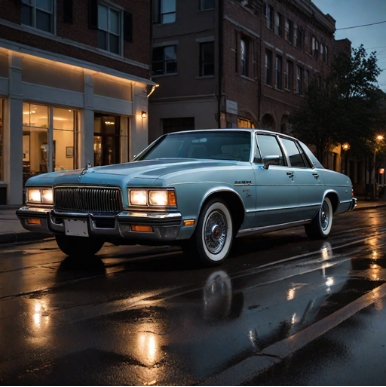The Benchmark: Charting the Evolution of the Mercedes-Benz M-Class
In the landscape of automotive history, few vehicles can claim to have created a segment entirely. The Ford Model T democratized the car, the Volkswagen Beetle brought motoring to the masses, and the Lamborghini Miura invented the supercar. In the mid-1990s, another revolution was brewing. Sport Utility Vehicles were rugged, utilitarian, and largely agricultural in their on-road manners. Luxury cars were refined, comfortable, and exclusively terrestrial. Mercedes-Benz, in a bold and prescient move, decided to fuse these two disparate concepts, creating a vehicle that would forever change the market: the M-Class. This is the story of its evolution, from a pioneering upstart to a polished and dominant force in the world of luxury SUVs.
First Generation (W163): The Trailblazer (1997-2005)
The genesis of the M-Class stemmed from a clear market opportunity. Wealthy buyers were flocking to capable but unrefined SUVs like the Ford Explorer and Jeep Grand Cherokee. Mercedes-Benz envisioned a vehicle that offered the all-weather capability and commanding driving position of an SUV but with the safety, comfort, and prestige of a Mercedes sedan.
The project, codenamed W163, was a significant departure for the Stuttgart-based automaker. For the first time, Mercedes-Benz established a full production facility in the United States, in Tuscaloosa, Alabama, specifically to build its new SUV for a global market. Bucking contemporary trends toward unibody construction for SUVs, Mercedes opted for a traditional body-on-frame design. This provided immense strength and off-road ruggedness, featuring a sophisticated full-time 4MATIC all-wheel-drive system with a low-range transfer case, controlled electronically via a button on the dashboard rather than a clunky secondary shifter.
The M-Class made its public debut not in an auto show, but on the silver screen, famously starring as the hero vehicle in the 1997 blockbuster Jurassic Park: The Lost World. This marketing masterstroke immediately cemented the vehicle’s image as both tough and technologically advanced.
When it officially launched for the 1998 model year, the initial reception was mixed. While its concept was lauded, early production models were plagued by quality control issues, earning it the unfortunate moniker of the “Alabama Merc.” However, Mercedes worked diligently to rectify these problems, and the vehicle’s inherent strengths soon won over the public.
Models and Trim Levels (W163):
- ML 320 (1997-2003): The launch model and volume seller, powered by a durable 3.2-liter M112 V6 engine producing 215 horsepower.
- ML 230 (1997-2000): A base model for Europe and other markets, featuring a 2.3-liter inline-four engine. It was never officially sold in North America.
- ML 430 (1998-2001): Introduced a year after launch, this model catered to the demand for V8 power with a 4.3-liter M113 V8 making 268 horsepower, offering significantly more performance.
- ML 55 AMG (1999-2003): A watershed moment. This was the world’s first high-performance luxury SUV, hand-assembled by AMG. Its 5.4-liter naturally aspirated V8 produced a formidable 342 horsepower, allowing the burly SUV to sprint from 0-60 mph in a sports-sedan-like 6.4 seconds. It featured aggressive bodywork, larger brakes, and a sport-tuned suspension.
- ML 270 CDI (1999-2005): A hugely popular model outside of North America, equipped with a 2.7-liter inline-five turbodiesel engine known for its torque and fuel efficiency.
.
THIS could come in handy for your auto garage (and everywhere else!):

.
The 2002 Facelift:
For the 2002 model year, the W163 received a significant mid-cycle refresh. This update addressed many of the early criticisms, vastly improving interior material quality and fit-and-finish. Externally, it received clear-lens headlights and taillights, and body-colored mirrors with integrated turn signals. The engine lineup was also revised.
- ML 500 (2002-2005): Replaced the ML 430. It used a larger 5.0-liter M113 V8, boosting output to 288 horsepower.
- ML 350 (2003-2005): Replaced the ML 320, featuring a larger 3.7-liter version of the M112 V6 with 232 horsepower.
- ML 400 CDI (2001-2005): A powerful V8 turbodiesel for European markets, this model delivered immense torque and high-speed cruising ability.
Second Generation (W164): Sophistication and Performance (2005-2011)
By the mid-2000s, the M-Class had formidable competitors like the BMW X5 and Porsche Cayenne. For its second generation, Mercedes-Benz completely re-engineered the vehicle. The rugged but truck-like body-on-frame chassis was abandoned in favor of a modern unibody construction. This single change transformed the M-Class, drastically improving its on-road handling, ride comfort, and crash safety.
The W164 was sleeker, more aerodynamic, and its design was more harmonious with the contemporary Mercedes-Benz passenger car lineup. The interior was a significant leap forward in luxury and technology, featuring the COMAND infotainment system, optional Airmatic air suspension, and advanced safety features like PRE-SAFE. The low-range transfer case became an optional part of an “Off-Road Pro” package, reflecting the reality that most owners spent their time on pavement.
Models and Trim Levels (W164):
- ML 350 (2005-2011): The core model in North America, now equipped with a new-generation 3.5-liter M272 V6 engine producing a healthier 268 horsepower.
- ML 500 / ML 550 (2005-2011): Powered by a new 5.0-liter V8 (and later a 5.5-liter V8 in North America, badged as the ML 550), it delivered a muscular 382 horsepower, making it a true autobahn missile.
- ML 320 CDI / ML 350 BlueTEC (2007-2011): This model marked the successful introduction of “clean diesel” to the American market. The 3.0-liter V6 turbodiesel offered V8-levels of torque with four-cylinder fuel economy, becoming a popular choice for long-distance drivers. The “BlueTEC” designation indicated the use of advanced emissions-reducing technology.
- ML 280 CDI & ML 420 CDI: Additional diesel variants primarily for Europe, offering a range of power and efficiency options.
- ML 63 AMG (2006-2011): The W164’s crowning achievement. This model shed any pretense of subtlety, housing AMG’s legendary M156 6.2-liter naturally aspirated V8. Pumping out 503 horsepower, it could rocket the SUV to 60 mph in under 5 seconds. It was a masterpiece of engineering, a thunderous and exhilarating machine that set a new benchmark for performance SUVs.
- ML 450 Hybrid (2009-2011): A late addition to the lineup, this was Mercedes’ first hybrid SUV. It used a complex two-mode hybrid system paired with a 3.5-liter V6 engine, offering improved city fuel economy, though it was sold in limited numbers.
A subtle facelift for the 2009 model year brought a revised grille, new bumpers, and updated interior electronics.
Third Generation (W166): The Pinnacle of the M-Class (2011-2015)
The third and final generation to wear the “M-Class” badge was the W166. Launched for the 2012 model year, it represented the culmination of everything Mercedes-Benz had learned. The design was more assertive and athletic, with chiseled body lines and distinctive LED lighting. The interior was where it truly shined, borrowing heavily from the luxurious E-Class and S-Class sedans with high-quality wood, leather, and metal trim, and a host of cutting-edge driver-assistance systems.
Efficiency became a major focus. The W166 introduced advanced engine start-stop technology across the range and placed a greater emphasis on turbocharged engines and clean diesel technology to meet tightening emissions and fuel economy standards.
Models and Trim Levels (W166):
- ML 350 BlueTEC 4MATIC (2011-2015): A refined version of the popular 3.0-liter turbodiesel V6, now producing 240 horsepower and a colossal 455 lb-ft of torque.
- ML 350 4MATIC (2011-2015): The gasoline V6 was updated with direct injection, boosting power to 302 horsepower while improving efficiency. A rear-wheel-drive version was also offered briefly, a first for the M-Class in the U.S.
- ML 550 4MATIC (2011-2015): The V8 model moved with the times, swapping the naturally aspirated unit for a smaller yet far more potent 4.7-liter bi-turbo V8. It produced 402 horsepower and an enormous wave of torque, available from very low RPM.
- ML 250 BlueTEC 4MATIC (2014-2015): A bold move, this model replaced the V6 diesel in some markets for the final model year. It used a 2.1-liter twin-turbo four-cylinder diesel engine. While down on horsepower (201 hp), its 369 lb-ft of torque provided ample performance for most drivers, along with exceptional fuel economy.
- ML 400 4MATIC (2014-2015): Introduced late in the cycle, this model bridged the gap between the ML 350 and ML 550. It featured a 3.0-liter bi-turbo V6 engine with 329 horsepower, offering V8-like acceleration with better efficiency.
- ML 63 AMG (2011-2015): The AMG model also embraced turbocharging. It was fitted with a 5.5-liter bi-turbo V8, producing 518 horsepower in standard form. An optional AMG Performance Package raised this to an incredible 550 horsepower, making it one of the fastest and most powerful SUVs on the planet.
The Transition: From M-Class to GLE-Class (2015-Present)
In 2015, as part of a company-wide restructuring of its model nomenclature, Mercedes-Benz announced that the M-Class would be renamed. The new system designated all SUVs with a “GL” prefix, followed by a letter indicating their position in the hierarchy relative to the core sedan lines (A, C, E, S). As the SUV equivalent of the E-Class sedan, the M-Class was logically rebranded as the GLE-Class.
This change coincided with the W166’s mid-cycle facelift for the 2016 model year. The updated vehicle received a new front fascia, revised taillights, and an updated interior featuring a larger, tablet-style infotainment screen. The name change also brought new models, including a sporty GLE Coupe to compete with the BMW X6 and the first M-Class-derived plug-in hybrid, the GLE 550e.
Though the M-Class name was retired, its legacy is undeniable. Over three generations, it evolved from a rugged but flawed pioneer into a polished, technologically advanced, and luxurious benchmark. It not only established Mercedes-Benz as a dominant player in the SUV market but fundamentally created and defined the premium SUV segment itself. Every luxury SUV on the road today owes a debt to the vision and ambition embodied in the original, game-changing Mercedes-Benz M-Class.







